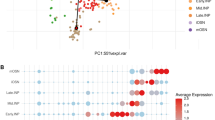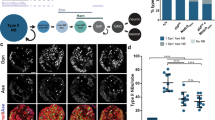Abstract
Neuronal-class diversification is central during neurogenesis. This requirement is exemplified in the olfactory system, which utilizes a large array of olfactory receptor neuron (ORN) classes. We discovered an epigenetic mechanism in which neuron diversity is maximized via locus-specific chromatin modifications that generate context-dependent responses from a single, generally used intracellular signal. Each ORN in Drosophila acquires one of three basic identities defined by the compound outcome of three iterated Notch signaling events during neurogenesis. Hamlet, the Drosophila Evi1 and Prdm16 proto-oncogene homolog, modifies cellular responses to these iteratively used Notch signals in a context-dependent manner, and controls odorant receptor gene choice and ORN axon targeting specificity. In nascent ORNs, Hamlet erases the Notch state inherited from the parental cell, enabling a modified response in a subsequent round of Notch signaling. Hamlet directs locus-specific modifications of histone methylation and histone density and controls accessibility of the DNA-binding protein Suppressor of Hairless at the Notch target promoter.
This is a preview of subscription content, access via your institution
Access options
Subscribe to this journal
Receive 12 print issues and online access
$209.00 per year
only $17.42 per issue
Buy this article
- Purchase on Springer Link
- Instant access to full article PDF
Prices may be subject to local taxes which are calculated during checkout







Similar content being viewed by others
References
Stevens, C.F. Neuronal diversity: too many cell types for comfort? Curr. Biol. 8, R708–R710 (1998).
Vosshall, L.B., Amrein, H., Morozov, P.S., Rzhetsky, A. & Axel, R. A spatial map of olfactory receptor expression in the Drosophila antenna. Cell 96, 725–736 (1999).
Couto, A., Alenius, M. & Dickson, B.J. Molecular, anatomical, and functional organization of the Drosophila olfactory system. Curr. Biol. 15, 1535–1547 (2005).
Fishilevich, E. & Vosshall, L.B. Genetic and functional subdivision of the Drosophila antennal lobe. Curr. Biol. 15, 1548–1553 (2005).
Mori, K. & Sakano, H. How is the olfactory map formed and interpreted in the mammalian brain? Annu. Rev. Neurosci. 34, 467–499 (2011).
Louvi, A. & Artavanis-Tsakonas, S. Notch signaling in vertebrate neural development. Nat. Rev. Neurosci. 7, 93–102 (2006).
Pires-daSilva, A. & Sommer, R.J. The evolution of signaling pathways in animal development. Nat. Rev. Genet. 4, 39–49 (2003).
Endo, K., Aoki, T., Yoda, Y., Kimura, K. & Hama, C. Notch signal organizes the Drosophila olfactory circuitry by diversifying the sensory neuronal lineages. Nat. Neurosci. 10, 153–160 (2007).
Bray, S. & Bernard, F. Notch targets and their regulation. Curr. Top. Dev. Biol. 92, 253–275 (2010).
Cooper, M.T. et al. Spatially restricted factors cooperate with Notch in the regulation of Enhancer of split genes. Dev. Biol. 221, 390–403 (2000).
Kramatschek, B. & Campos-Ortega, J.A. Neuroectodermal transcription of the Drosophila neurogenic genes E(spl) and HLH-m5 is regulated by proneural genes. Development 120, 815–826 (1994).
Swanson, C.I., Evans, N.C. & Barolo, S. Structural rules and complex regulatory circuitry constrain expression of a Notch- and EGFR-regulated eye enhancer. Dev. Cell 18, 359–370 (2010).
Kinameri, E. et al. Prdm proto-oncogene transcription factor family expression and interaction with the Notch-Hes pathway in mouse neurogenesis. PLoS ONE 3, e3859 (2008).
Moore, A.W., Jan, L.Y. & Jan, Y.N. hamlet, a binary genetic switch between single- and multiple- dendrite neuron morphology. Science 297, 1355–1358 (2002).
Moore, A.W., Roegiers, F., Jan, L.Y. & Jan, Y.N. Conversion of neurons and glia to external cell fates in the external sensory organs of Drosophila hamlet mutants by a cousin-cousin cell-type respecification. Genes Dev. 18, 623–628 (2004).
Lu, B., Rothenberg, M., Jan, L.Y. & Jan, Y.N. Partner of Numb colocalizes with Numb during mitosis and directs Numb asymmetric localization in Drosophila neural and muscle progenitors. Cell 95, 225–235 (1998).
Hayashi, S. et al. GETDB, a database compiling expression patterns and molecular locations of a collection of Gal4 enhancer traps. Genesis 34, 58–61 (2002).
Andrews, H.K., Giagtzoglou, N., Yamamoto, S., Schulze, K.L. & Bellen, H.J. Sequoia regulates cell fate decisions in the external sensory organs of adult Drosophila. EMBO Rep. 10, 636–641 (2009).
Wang, S., Younger-Shepherd, S., Jan, L.Y. & Jan, Y.N. Only a subset of the binary cell fate decisions mediated by Numb/Notch signaling in Drosophila sensory organ lineage requires Suppressor of Hairless. Development 124, 4435–4446 (1997).
Abdelilah-Seyfried, S. et al. A gain-of-function screen for genes that affect the development of the Drosophila adult external sensory organ. Genetics 155, 733–752 (2000).
Kajimura, S. et al. Regulation of the brown and white fat gene programs through a PRDM16/CtBP transcriptional complex. Genes Dev. 22, 1397–1409 (2008).
Izutsu, K. et al. The corepressor CtBP interacts with Evi-1 to repress transforming growth factor beta signaling. Blood 97, 2815–2822 (2001).
Palmer, S. et al. Evi-1 transforming and repressor activities are mediated by CtBP co-repressor proteins. J. Biol. Chem. 276, 25834–25840 (2001).
Rand, M.D. et al. Calcium depletion dissociates and activates heterodimeric Notch receptors. Mol. Cell. Biol. 20, 1825–1835 (2000).
Krejcí, A. & Bray, S. Notch activation stimulates transient and selective binding of Su(H)/CSL to target enhancers. Genes Dev. 21, 1322–1327 (2007).
Mukherjee, A. et al. Regulation of Notch signaling by non-visual beta-arrestin. Nat. Cell Biol. 7, 1191–1201 (2005).
Seale, P. et al. Transcriptional control of brown fat determination by PRDM16. Cell Metab. 6, 38–54 (2007).
Völkel, P. & Angrand, P.O. The control of histone lysine methylation in epigenetic regulation. Biochimie 89, 1–20 (2007).
Shi, Y. et al. Coordinated histone modifications mediated by a CtBP co-repressor complex. Nature 422, 735–738 (2003).
Chinnadurai, G. Transcriptional regulation by C-terminal binding proteins. Int. J. Biochem. Cell Biol. 39, 1593–1607 (2007).
Mikkelsen, T.S. et al. Genome-wide maps of chromatin state in pluripotent and lineage-committed cells. Nature 448, 553–560 (2007).
Bernstein, B.E. et al. Methylation of histone H3 Lys 4 in coding regions of active genes. Proc. Natl. Acad. Sci. USA 99, 8695–8700 (2002).
Schneider, R. et al. Histone H3 lysine 4 methylation patterns in higher eukaryotic genes. Nat. Cell Biol. 6, 73–77 (2004).
Suh, G.S. et al. A single population of olfactory sensory neurons mediates an innate avoidance behavior in Drosophila. Nature 431, 854–859 (2004).
Kurtovic, A., Widmer, A. & Dickson, B.J. A single class of olfactory neurons mediates behavioral responses to a Drosophila sex pheromone. Nature 446, 542–546 (2007).
Ray, A., van Naters, W.G., Shiraiwa, T. & Carlson, J.R. Mechanisms of odor receptor gene choice in Drosophila. Neuron 53, 353–369 (2007).
Bai, L., Goldman, A.L. & Carlson, J.R. Positive and negative regulation of odor receptor gene choice in Drosophila by Acj6. J. Neurosci. 29, 12940–12947 (2009).
Tichy, A.L., Ray, A. & Carlson, J.R. A new Drosophila POU gene, pdm3, acts in odor receptor expression and axon targeting of olfactory neurons. J. Neurosci. 28, 7121–7129 (2008).
Komiyama, T., Carlson, J.R. & Luo, L. Olfactory receptor neuron axon targeting: intrinsic transcriptional control and hierarchical interactions. Nat. Neurosci. 7, 819–825 (2004).
Chou, Y.H., Zheng, X., Beachy, P.A. & Luo, L. Patterning axon targeting of olfactory receptor neurons by coupled hedgehog signaling at two distinct steps. Cell 142, 954–966 (2010).
Gupta, B.P. & Rodrigues, V. atonal is a proneural gene for a subset of olfactory sense organs in Drosophila. Genes Cells 2, 225–233 (1997).
Bray, S. & Furriols, M. Notch pathway: making sense of suppressor of hairless. Curr. Biol. 11, R217–R221 (2001).
Pierfelice, T.J., Schreck, K.C., Eberhart, C.G. & Gaiano, N. Notch, neural stem cells, and brain tumors. Cold Spring Harb. Symp. Quant. Biol. 73, 367–375 (2008).
He, S., Nakada, D. & Morrison, S.J. Mechanisms of stem cell self-renewal. Annu. Rev. Cell Dev. Biol. 25, 377–406 (2009).
Lim, D.A. et al. Chromatin remodeling factor Mll1 is essential for neurogenesis from postnatal neural stem cells. Nature 458, 529–533 (2009).
Magklara, A. et al. An epigenetic signature for monoallelic olfactory receptor expression. Cell 145, 555–570 (2011).
Wagh, D.A. et al. Bruchpilot, a protein with homology to ELKS/CAST, is required for structural integrity and function of synaptic active zones in Drosophila. Neuron 49, 833–844 (2006).
Kanai, M.I., Okabe, M. & Hiromi, Y. seven-up controls switching of transcription factors that specify temporal identities of Drosophila neuroblasts. Dev. Cell 8, 203–213 (2005).
Matsuzaki, F., Koizumi, K., Hama, C., Yoshioka, T. & Nabeshima, Y. Cloning of the Drosophila prospero gene and its expression in ganglion mother cells. Biochem. Biophys. Res. Commun. 182, 1326–1332 (1992).
Acknowledgements
We thank L. Luo, T. Hummel, Y. Hiromi, Y.N. Jan, F. Matsuzaki, S. Parkhurst, the Bloomington Drosophila Stock Center, Bloomington Drosophila Genomics Resource Center, the Iowa Developmental Studies Hybridoma Bank and Flybase for Drosophila stocks, DNA clones, antibodies and indispensable database information, and C. Yokoyama and members of the Moore laboratory for advice on the manuscript. Funding was provided by Japan Society for the Promotion of Science Grants-in-Aid Young Scientists (B) to H.T. and Scientific Research (C) to K.E., a RIKEN–Deutscher Akademischer Austauschdienst Research Internship Scholarship to M.S., a Medical Research Council program grant to S.J.B., and a RIKEN Brain Science Institute core award to A.W.M.
Author information
Authors and Affiliations
Contributions
K.E., M.R.K., E.K., M.S., S.J.B. and A.W.M. carried out genetic analyses. H.T., A.K., E.K. and M.S. carried out molecular biology. K.E., K.I., S.J.B. and A.W.M. wrote the paper. A.W.M. conceived and coordinated the study.
Corresponding author
Ethics declarations
Competing interests
The authors declare no competing financial interests.
Supplementary information
Supplementary Text and Figures
Supplementary Figures 1–8 and Supplementary Table 1 (PDF 889 kb)
Rights and permissions
About this article
Cite this article
Endo, K., Karim, M., Taniguchi, H. et al. Chromatin modification of Notch targets in olfactory receptor neuron diversification. Nat Neurosci 15, 224–233 (2012). https://doi.org/10.1038/nn.2998
Received:
Accepted:
Published:
Issue Date:
DOI: https://doi.org/10.1038/nn.2998
This article is cited by
-
Sensory neuron lineage mapping and manipulation in the Drosophila olfactory system
Nature Communications (2019)
-
Strength in diversity: functional diversity among olfactory neurons of the same type
Journal of Bioenergetics and Biomembranes (2019)
-
Linking neuronal lineage and wiring specificity
Neural Development (2018)
-
Opposite effects of HDAC5 and p300 on MRTF-A-related neuronal apoptosis during ischemia/reperfusion injury in rats
Cell Death & Disease (2017)
-
Patterns of transcriptional parallelism and variation in the developing olfactory system of Drosophila species
Scientific Reports (2017)



